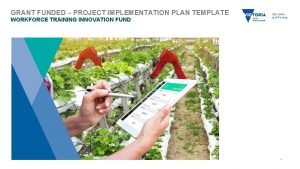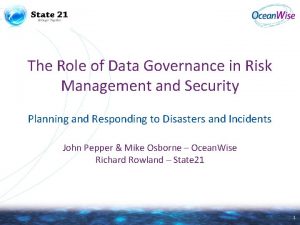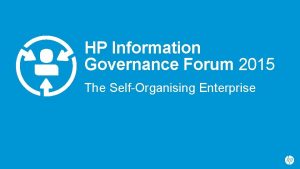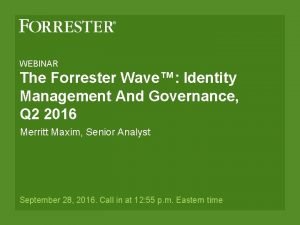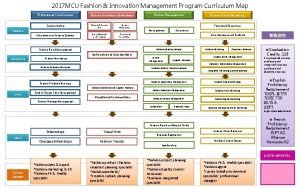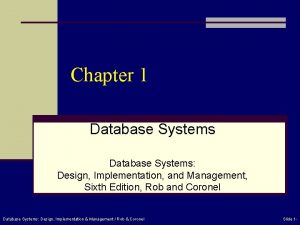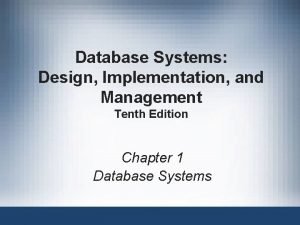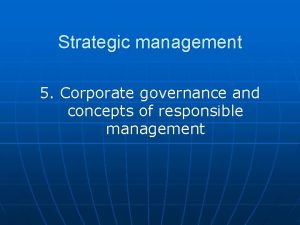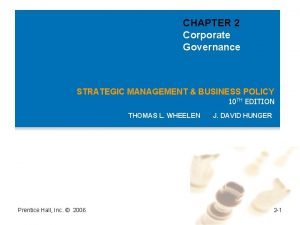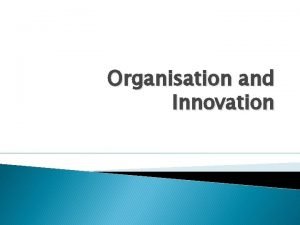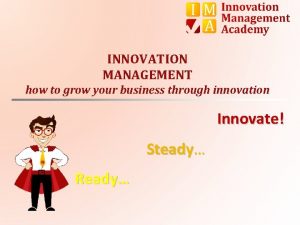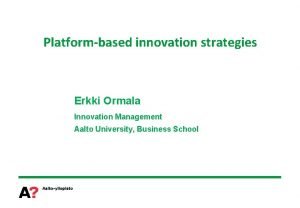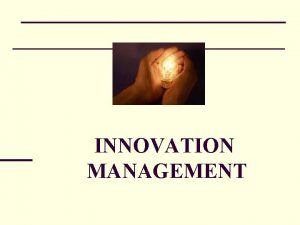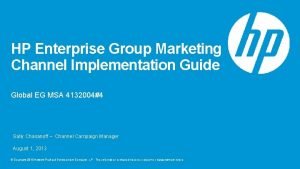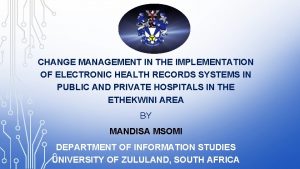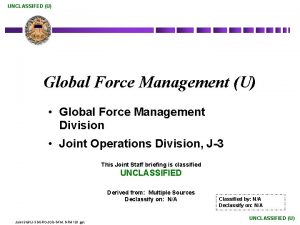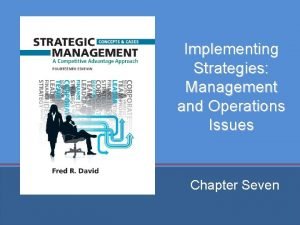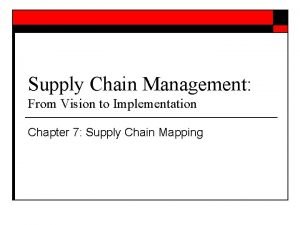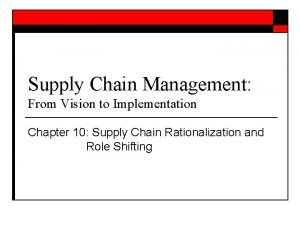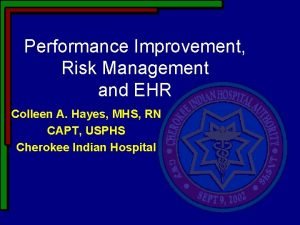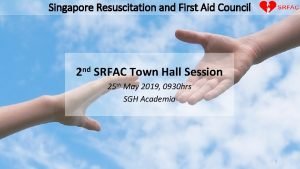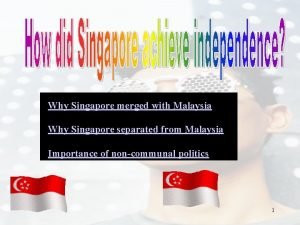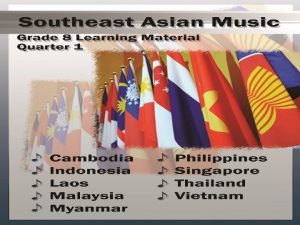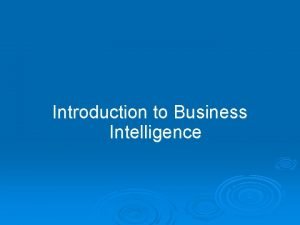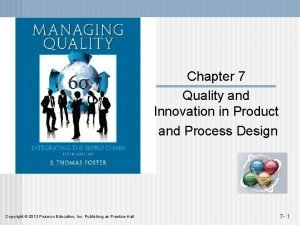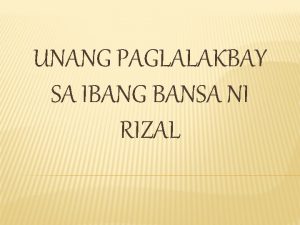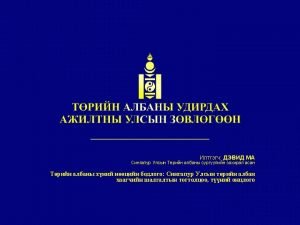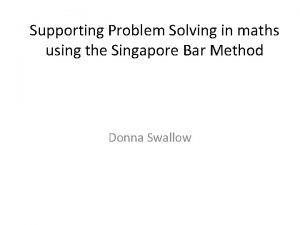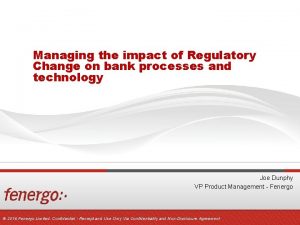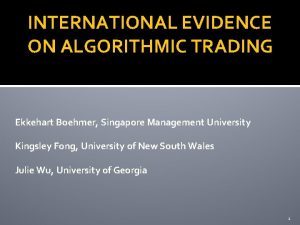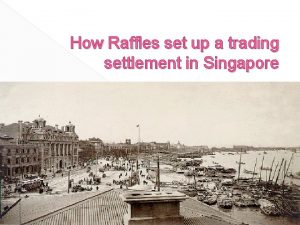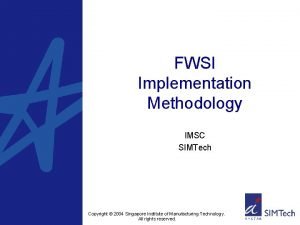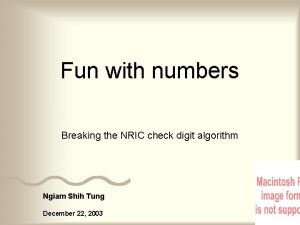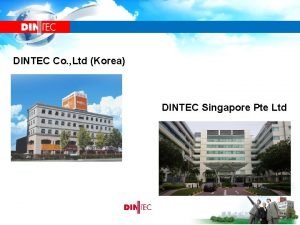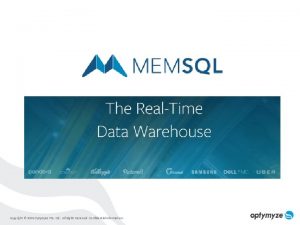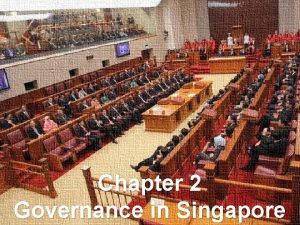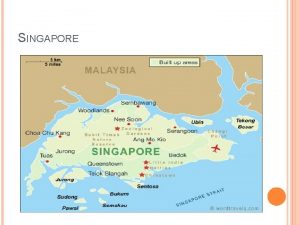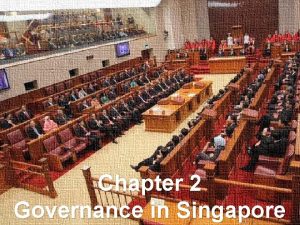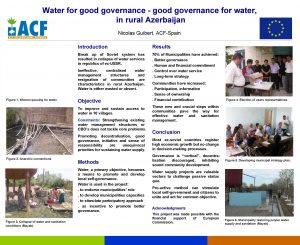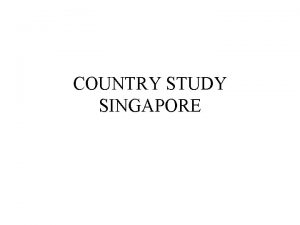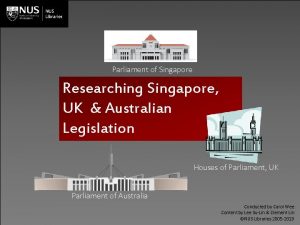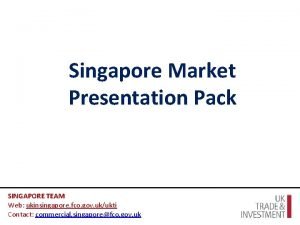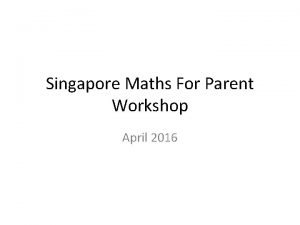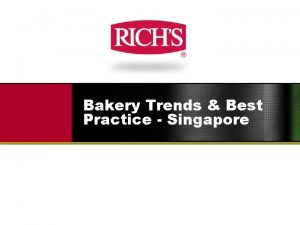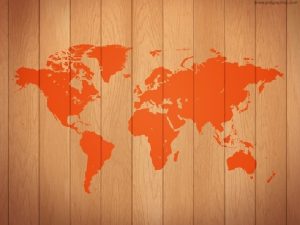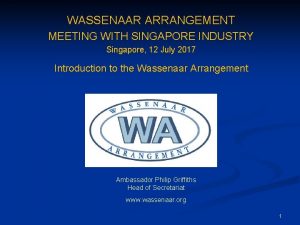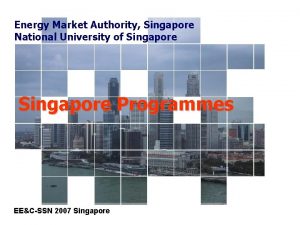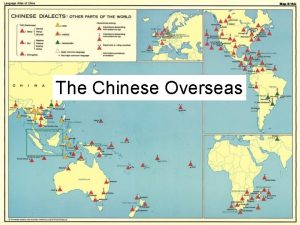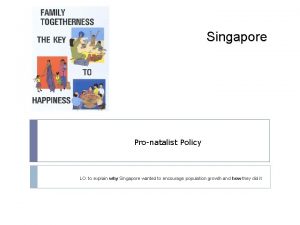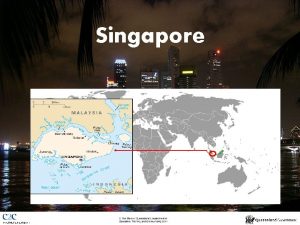WATER GOVERNANCE MANAGEMENT IN SINGAPORE Innovation Implementation and






















































- Slides: 54

WATER GOVERNANCE & MANAGEMENT IN SINGAPORE – Innovation, Implementation and Laws Lye Lin-Heng Deputy Director, Asia-Pacific Centre for Environmental Law (APCEL) Faculty of Law, National University of Singapore IUCN Academy of Environmental Law 9 th Colloquium July 2011, South Afrtca 1 LH Lye, APCEL

2 LH Lye, APCEL

3 LH Lye, APCEL

Reservoirs in Singapore 4 LH Lye, APCEL

SINGAPORE – ISLAND / CITY-STATE 5 LH Lye, APCEL

Water Resources and Management Ø Land area - 710 sq km, very urbanized, 193 km coastline Ø Hot and humid - Average daily temperature – 25 -31 degree Celsius Ø Population – 5 million (2010) Ø Govt. intends to increase population to 6. 5 m Ø Water challenges (past): - - Lack natural freshwater resources: tiny state, no large rivers - Reliance on rain and wells - Periods of droughts - Tropical storms (monsoons) brought floods 6 LH Lye, APCEL

Challenges to Water Management 2, 400 mm rainfall per year, c/p global average of 1, 050 mm. UN classified Singapore as a water scarce country. -Ranked 170 th out of 190 countries with fresh water availability Droughts - need for water rationing Dependent on purchase of water from Malaysia 7 LH Lye, APCEL

SINGAPORE’S WATER CHALLENGES April 1963 -Feb 1964 – drought, water rationing 6 hours a day, 4 times a week, extended to 12 hours a day, 3 times a week) Water an issue of national security ; to cease dependence on Malaysia, vulnerability Increased population and industries strained resources need to be self-sufficient in water Global warming & climate change– may cause water crisis “More and more cities and countries see access to water as a security concern and a potential trigger of conflict” – per PM Lee Hsien Loong, Water Summit in Singapore, 24 June 2008 8 LH Lye, APCEL

9 LH Lye, APCEL

10 LH Lye, APCEL

11 LH Lye, APCEL

The Public Utilities Board (PUB) – Early years 1963 – establishment of Public Utilities Board (PUB) – statutory board to coordinate supply of water, electricity, piped gas. PUB also to improve and expand available water resources 3 reservoirs (Mac. Ritchie, Peirce & Seletar) The Singapore & Kallang Rivers cover 1/5 of Singapore’s land area and flows through the central city but ecologically dead, highly contaminated 12 LH Lye, APCEL



15 LH Lye, APCEL

Last night soil buckets phased out January 1987 16 LH Lye, APCEL



Purchase of water from Malaysia 1927 – 1 st water agreement between colonial govt & 19 Johor state; expired Today, 3 agreements: 1. 1961 – 50 year Agreement till 2011 2. 1962 – 99 year Agreement till 2061 Both Agreements allowed S’pore to draw water from Johor, paying rent for land area and 3 cents per 1000 gallons. In turn S’pore sells Johor treated water at 50 cents per 1000 gallons. Agreements guaranteed under the Separation Agreement on 9 August 1965 when Singapore separated from Malaysia 3. 1990 Agreement – supplemental to 1962 agreement, expires 2061 LH Lye, APCEL

Achieving Water Sufficiency – Good Governance & Management Policies - “every drop counts” 2. Clean up polluted rivers, resettle riverfolk with compensation 3. Build infrastructure – Modern sanitation and sewerage treatment plants, trade effluent treatment, new reservoirs 4. Water harvesting & recycling – build drainage systems to collect rainwater, sewage, sullage and trade effluent 5. Prevent pollution through laws, land use planning 6. Invest in R & D – NEWater (membrane LH Lye, APCEL technology, ) de-salination) 1. 20

Singapore’s 4 taps – water sources today Rainfall – collected in reservoirs & water catchment areas (20%) Imported water from Malaysia (40% - down from 50% since 2009) Reclaimed water –NEWater (30%) Sea water desalination (10%) ……………. . Aim – to reduce reliance on imported water by increasing volume from the 3 ‘national taps’ Singapore has declared it will not renew 1961 water agreement with Johor on expiry 2011 21 LH Lye, APCEL

I. Innovation: Technology – Reclaimed water - NEWater is brand name for reclaimed water – treated waste water (sewage) purified using dual membrane (via microfiltration and reverse osmosis) & ultraviolet technologies, in addition to conventional water treatment processes First 2 plants started end 2002 (Bedok & Kranji) As of 2010, there are 5 NEWater factories producing 50 million gallons per day : - for wafer fabrication plants & other non-potable industrial use - the rest is fed into nearby reservoirs 22 LH Lye, APCEL

23 LH Lye, APCEL

Reclaimed water – Deep Tunnel Sewerage System The Deep Tunnel Sewerage System (DTSS) is an important component of Singapores water management strategy as it allows every drop of used water to be collected, treated and further purified into NEWater, Singapore’s own brand of reclaimed water. Singapore’s fifth and largest NEWater plant is built on the rooftop of the Changi Water Reclamation Plant, the first of its kind in the world. Integrating the NEWater plant with the DTSS allows for efficient, large-scale water recycling, thus ensuring the sustainability of NEWater. Opened in May 2010, this NEWater plant at Changi has a capacity of 50 mgd. With this addition, coupled with the expansion of the existing four NEWater plants, NEWater now meets 30% of Singapore’s total water demand. 24 LH Lye, APCEL

Desalinated Water - 2005 The Sing. Spring Desalination Plant - reverse osmosis technology Lowest desalinated water price in the world – first year at 0. 48/m 3 Energy recovery system Won distinction in 2006 Global Water Award June 2010 - Tender called for 2 nd 25 desalination plant 30 June 2010, completion in 2013, to supply water LH Lye, APCEL

26 LH Lye, APCEL

New reservoirs Marina Barrage - 2008 15 th and largest reservoir In estuary of river that has 27 been closed off by a barrage to keep out sea water Desalting through natural process of replacement by rain water Sluice gates also help in flood control 2 similar barrages due for completion in 2011 to LH Lye, APCEL form Punggol and Serangoon Reservoirs

28 LH Lye, APCEL

Marina Barrage, Singapore 29 LH Lye, APCEL

Marina Barrage – flood control 30 LH Lye, APCEL

II. Application Singapore ‘s water supply system today 7, 000 km drainage network which directs water into 31 19 raw water reservoirs 9 treatment works 17 service reservoirs for treated water 4 plants that recycle sewage water using membrane technology “NEWater” – meets 30% of Singapore’s water demand 1 desalination plant 2/3 of land area now a catchment area, supplies 60% of island’s water needs 100% have access to water, affordable, efficient and of high quality; 100% sewered LH Lye, APCEL

III, Water Governance Framework Ministry of Environment & Water Resources (MEWR) 32 renamed on 1 July 2002 from Ministry of Environment: - National Environment Agency (NEA – pollution) - Public Utilities Board (PUB) PUB - comprehensive water authority, integrates sewerage & drainage departments - manages reservoirs, water works, rivers, drainage system, water reclamation plants, and sewerage system, to optimise use of Singapore’s water resources. Vision “Water for all – Conserve, Value, Enjoy” LH Lye, APCEL ABC – Active, Beautiful, Clean waters program by

PUB’s Vision “Water for All Conserve, Value, Enjoy” Water for all – Singapore has ensured a stable and sustainable supply of water via integrated water management system and 4 sources of water called the Four National Taps 2. Conserve – wide-ranging initiatives to encourage people and industries to use water wisely. Target: to lower per capita domestic consumption to 140 litres by 2030 (now 157). 3. Value – community outreach programs to encourage people to keep waterways clean and take ownership of water resources 4. Enjoy – water activities introduced at reservoirs to encourage people to be closer to water so they will LH Lye, APCEL care for it. 1. 33

PUB’s “Water Loop” - http: //www. pub. gov. sg/about/Pages/default. aspx 34 LH Lye, APCEL

Water Tariffs (US$1. 00 to S$1. 25) Water tariffs set at level allowing cost recovery, including capital costs PUB issued bond in 2005 – raised $400 M to finance part of its investment program Water conservation tax – now set at 30% but 45% tax for domestic consumption above 40 m 3 per month & connection From 2010, domestic tariff without taxes is set at S$1. 17/m 3 for consumption below 40 m 3 per month & $1. 40 m 3 for higher consumption Industrial water tariffs - $0. 43/m 3. 35 LH Lye, APCEL

Sewerage Tariff The sewerage tariff (called “waterborne fee”) is 36 S$0. 30/m 3 for domestic users independent of consumption $3 per sanitary fitting (WC) per month Add water conservation tax of 30% Add GST – 7% Thus, water & sewerage tariff including taxes is about $1. 62 A household consuming 20 m 3 per month with 3 toilets would pay $41. 45 pm or S 2. 08 per m 3. Water tariffs were raised substantially in late 1990 s, so that average monthly domestic bill LH Lye, APCEL including taxes increased from $13 in 1996 to $30 in

Water laws - hard laws Public Utilities Act, 2001 See Part IV – supply of water for human consumption s. 50 – Offences: making unauthorised connections, contaminating water, wasting water, wilfully interfere with or disrupt supply of water – fine $1000. (Note: unaccounted for water (Uf. W) is major problem in developing countries; In Singapore, early 1980 s, Uf. W was 110% of total outpute. Today, only 5. 18%)) PU (Water Tariff) Regulations – water conservation tax PU (Water Supply) Regulations – water metering and water saving devices are mandatory, also low capacity flush cisterns wef April 1997 (3. 5 -4. 5 litres per flush) PU (Catchment Area Parks) Regulations 2006 LH Lye, APCEL I. 37

2. Sewerage and Drainage Act, 1999 SEWERAGE AND DRAINAGE (SANITARY APPLIANCES AND WATER CHARGES) REGULATIONS Cap/SL No. : Cap. 294, Regulation 1 SEWERAGE AND DRAINAGE (SANITARY WORKS) REGULATIONS Cap/SL No. : Cap. 294, Regulation 2 SEWERAGE AND DRAINAGE (SEWAGE TREATMENT PLANTS) REGULATIONS Cap/SL No. : Cap. 294, Regulation 3 SEWERAGE AND DRAINAGE (SURFACE WATER DRAINAGE) REGULATIONS Cap/SL No. : Cap. 294, Regulation 4 SEWERAGE AND DRAINAGE (TRADE EFFLUENT) REGULATIONS Cap/SL No. : Cap. 294, Regulation 5 SEWERAGE AND DRAINAGE (COMPOSITION OF OFFENCES) REGULATIONS Cap/SL No. : Cap. 294, Regulation 6 SEWERAGE AND DRAINAGE (APPLICATION FEES) REGULATIONS Cap/SL No. : Cap. 294, Regulation 7 38 LH Lye, APCEL

Other laws 3. Environmental Protection and Management Act, 1999 (EPMA) EPM (Trade Effluent Regulations) EPM (Toxic Industrial Waste) Regulations - Water pollution control - Discharge of toxic and hazardous substances into inland waters - treatment of trade effluent - removal and clean up of polluting substances - list of toxic industrial waste 39 LH Lye, APCEL

4. Environmental Public Health Act (EPHA), 1987 EPHA Sections 51 -59 – sanitary conveniences, drains, sewers and wells. EPH (Quality of Piped Drinking Water) Regulations, 2008 EPH (Public Cleansing) Regulations 40 LH Lye, APCEL

5. Prevention of Pollution of the Sea Act “An Act to give effect to the International Convention for the Prevention of Pollution from Ships 1973 as modified and added to by the Protocol of 1978, and to other international agreements relating to the prevention, reduction and control of pollution of the sea and pollution from ships; to make provisions generally for the protection of the marine environment and for the prevention, reduction and control of pollution of the sea and pollution from ships, and for matters related thereto. ” 41 LH Lye, APCEL

5. Prevention of Pollution of the Sea Act Subsidiary laws PREVENTION OF POLLUTION OF THE SEA (OIL) REGULATIONS 42 Cap/SL No. : Cap. 243, Regulation 1 PREVENTION OF POLLUTION OF THE SEA (NOXIOUS LIQUID SUBSTANCES IN BULK) REGULATIONS Cap/SL No. : Cap. 243, Regulation 2 PREVENTION OF POLLUTION OF THE SEA (REPORTING OF POLLUTION INCIDENTS) REGULATIONS Cap/SL No. : Cap. 243, Regulation 3 PREVENTION OF POLLUTION OF THE SEA (RECEPTION FACILITIES AND GARBAGE FACILITIES) REGULATIONS Cap/SL No. : Cap. 243, Regulation 4 PREVENTION OF POLLUTION OF THE SEA (OIL POLLUTION PREPAREDNESS, RESPONSE AND CO-OPERATION) REGULATIONS Cap/SL No. : Cap. 243, Regulation 5 PREVENTION OF POLLUTION OF THE SEA (COMPOSITION OF OFFENCES) REGULATIONS Cap/SL No. : Cap. 243, Regulation 6 PREVENTION OF POLLUTION OF THE SEA (GARBAGE) REGULATIONS Cap/SL No. : Cap. 243, Regulation 7 PREVENTION OF POLLUTION OF THE SEA (HAZARDOUS AND NOXIOUS SUBSTANCES POLLUTION PREPAREDNESS, RESPONSE AND CO-OPERATION) REGULATIONS 2004 Cap/SL No. : S 120/2004 PREVENTION OF POLLUTION OF THE SEA (AIR) REGULATIONS 2005 Cap/SL No. : S 134/2005 PREVENTION OF POLLUTION OF THE SEA (SEWAGE) REGULATIONS 2005 Cap/SL No. : S 135/2005 PREVENTION OF POLLUTION OF THE SEA (OIL) REGULATIONS 2006 Cap/SL No. : S 685/2006 PREVENTION OF POLLUTION OF THE SEA (NOXIOUS LIQUID SUBSTANCES IN BULK) REGULATIONS 2006 Cap/SL No. : S 686/2006 PREVENTION OF POLLUTION OF THE SEA (HARMFUL ANTIFOULING SYSTEMS) REGULATIONS 2010 Cap/SL No. : S 198/2010 LH Lye, APCEL

Water Laws – Codes of Practice & Guidebooks National Environmenta. Agency EPM - Code of Practice on Pollution Control EPH - Code of Practice on Piped Drinking Water and Safety Plans - Every supplier required to prepare and implement a water safety plan and water sampling to ensure that piped drinking water complies with standards required. Penalty – fine $10, 000, $500 daily fine. - - water supplier also required to keep records Guidebooks (NEA) Mandatory Requirements for Public Toilets A Guide to Better Public Toilet Design and Maintenance 43 LH Lye, APCEL

PUB codes of practice PUB – Code of Practice on Sewerage and Sanitary Works – This contains information on the minimum requirements in the design and construction of sewerage and sanitary works. The requirements stated are also supplementary to the Sewerage and Drainage (Sanitary Works) Regulations. Code of Practice on Surface Water Drainage -This contains information on the basic planning, design and procedural requirements for surface water drainage, and specifies the minimum engineering requirements for the provision of functional facilities for surface water drainage. General amendments and revisions are expected from time to time. Singapore Standard CP 48 : Code of Practice for Water Services - This is published by SPRING Singapore and it contains authoritative guidance on the design, installation, fixing and testing of potable water service installations in all residential, commercial and industrial buildings or premises. 44 LH Lye, APCEL

Efficiency in Management of Water Services Procedure for Water Service Use of Guidebooks – (1) (2) (3) 45 Handbook on application for water supply PUB specifies fittings and standards for water service, reviews regularly PUB reviews the standards and requirements stipulated for water fittings regularly to allow for innovation and changes in technology and to ensure relevance. All plumbers must be licensed PUB adopts a simplified procedure for the design, installation and inspection of water service installations within the customer's premises. Water service workers, i. e. Professional Engineers (PEs) or the Licensed Water Service Plumbers (LWSPs), need not obtain PUB's approval for the detailed water reticulation system drawings and apply for an inspection before turn-on of the water supply. The procedure requires the water service workers to notify PUB before commencement of water service works by submitting the site plans and schematic drawings of the water service installation. Upon completion of the water service works, water service workers are required to submit a Certificate of Satisfactory Completion of Water Service Work certifying that the water service installation is completed in accordance with the Public Utilities (Water Supply) Regulations, Singapore Standard CP 48 - Code of Practice for Water Services, all other relevant statutory requirements and other PUB requirements. LH Lye, APCEL

Licensing of plumbers /engineers All water service plumbing works can only be carried out by a water service plumber licensed by PUB. Where the work involves the design of a pumping system or storage tank, a professional engineer registered by the Professional Engineers Board, Singapore must also be engaged for the design and supervision before the licensed water service plumber can proceed with the work. The professional engineers and licensed water service plumbers shall comply with the requirements in the Singapore Standard CP 48 - Code of Practice for Water Services, the Public Utilities (Water Supply) Regulations and the Public Utilities Act when carrying out water service design and installation works. Water service plumbers are licensed by PUB to ensure that the safety and water conservation aspects of drinking water supply are not compromised and good standard of water service plumbing work is maintained in customers' premises. Licences are issued to water service plumbers who possess the necessary qualifications and experience to maintain quality service and standards in water service plumbing work and to ensure that their work does not cause water wastage or contaminate the water supply to customers. Under the Public Utilities Act, it is an offence for anyone to engage a plumber who is not licensed by PUB to carry out water service plumbing work. It is also an offence for anyone to carry out water service plumbing work or advertise or otherwise hold himself out as a licensed water service plumber without a valid PUB Water Service Plumber Licence. The penalty for such offences is a fine not exceeding $10, 000 or imprisonment for a term not exceeding 3 years or both. PUB does not license plumbers for sanitary plumbing work. 46 LH Lye, APCEL

The Public Utilities Board (PUB) “Water for All” “Conserve, Value, Enjoy” ABC Waters – “Active, Beautiful and Clean” Efficient – 24 hour hotline (see PUB website) Comprehensive planning for water pipes, drainage lines, sewerage systems Licensing of contractors and engineers Codes of Practice to guide practitioners in the industry re: plumbing, toilets, sewerage works etc. 47 LH Lye, APCEL

48 LH Lye, APCEL

49 LH Lye, APCEL

50 LH Lye, APCEL

Singapore’s successes 2006 – PUB won “Water Agency of the Year Award” at the Global 51 Water Awards, Dubai (organised by Global Water Intelligence) 2007 – won Stockholm Industry Water Award. This is a prestigious prize which recognises innovative corporate development of water and wastewater process technologies. 2009 – Deep Tunnel Sewerage System won “Water Project of the Year” at Global Water Awards, Zurich Future – continued challenges to excel; investments in Research and Development (R & D) for new water technologies; new sources of expertise that can be replicated elsewhere, new economic strategy for Singapore – water expertise. See success of Hyflux, homegrown water company. http: //www. hyflux. com/ “a leading provider of integrated water management and environmental solutions with operations and projects in Singapore, Southeast Asia, China, India, Algeria, the Middle East and North Africa”. LH Lye, APCEL

Singapore - the Global “Hydrohub” Asia’s water market – worth US$120 billion a year World demand for clean water will triple by 2030 Investments in water technology paid off – S’pore now a centre for water research to develop new water solutions - development of new generation membranes S’pore water companies building infrastructure for others eg world’s largest desalination plant in Algeria Env & Water Industry Dev’mt Council – raises status of water industry & international role as water hub for business Govt strongly supportive of R & D Centres and alliances eg. Singapore. Delft Water Alliance between NUS, PUB and Delft Hydraulics Singapore houses over 50 water companies including GE Water, Siemens Water Tecnologies, Nitto Denko & Black & Veatch, plus homegrown companis. 52 LH Lye, APCEL

THE FUTURE – PUB’s strategy announced in June 2010 Singapore wants to achieve self-sufficiency in water by 53 2060 before its water agreement with Malaysia expires in 2061, even though water demand expected to double in 50 years To triple output of recycled water by 2060 - NEWater expected to account for half of projected needs To expand catchments to 90 % of land area, “to collect every drop of rain” 6 th NEWater plant to be built in conjunction with second phase of Deep Tunnel Sewerage System Desalination to meet 30% of water demand – research on going re: lowering energy costs Second desalination plant to be built LH Lye, APCEL Conservation remains the key – All must use water

54 LH Lye, APCEL
 Water and water and water water
Water and water and water water Arnim wiek
Arnim wiek Mysite.socccd
Mysite.socccd Radical vs disruptive innovation
Radical vs disruptive innovation Innovation implementation plan example
Innovation implementation plan example Data governance and risk management
Data governance and risk management Hpe information management and governance
Hpe information management and governance Forrester wave iam
Forrester wave iam Dynamics 365 risk management
Dynamics 365 risk management Higher certificate in local governance and management
Higher certificate in local governance and management Governance leadership and management
Governance leadership and management Fashion and innovation management
Fashion and innovation management Database systems: design, implementation, and management
Database systems: design, implementation, and management Database systems design implementation
Database systems design implementation What is ownership
What is ownership Corporate governance in strategic management
Corporate governance in strategic management Corporate governance strategic management
Corporate governance strategic management Slack
Slack Oracle product lifecycle management cloud
Oracle product lifecycle management cloud Imitator pathfinder
Imitator pathfinder Repetativt
Repetativt Ormala
Ormala Introduction to innovation
Introduction to innovation What is innovation management
What is innovation management Mdm implementation plan
Mdm implementation plan Campaign management implementation guide
Campaign management implementation guide Change management in ehr implementation
Change management in ehr implementation Global force management implementation guidance
Global force management implementation guidance Management issues central to strategy implementation
Management issues central to strategy implementation Management issues central to strategy implementation
Management issues central to strategy implementation Supply chain management from vision to implementation
Supply chain management from vision to implementation Supply base rationalization and optimization
Supply base rationalization and optimization Ehr risk management
Ehr risk management Srfac singapore
Srfac singapore Charles and keith swot analysis
Charles and keith swot analysis Why did singapore want to merge with malaysia
Why did singapore want to merge with malaysia The song listed below belong to the different countries
The song listed below belong to the different countries Freshwater allowance
Freshwater allowance Intelligence creation and use and bi governance
Intelligence creation and use and bi governance Quality and innovation in product and process design
Quality and innovation in product and process design Rick griffith
Rick griffith Paglalakbay ni rizal sa london
Paglalakbay ni rizal sa london Largest employer in singapore
Largest employer in singapore Sue has 4 pieces of wood
Sue has 4 pieces of wood Fenergo singapore fatca
Fenergo singapore fatca Algorithmic trading singapore
Algorithmic trading singapore Cashews clei
Cashews clei Singapore math concrete-pictorial-abstract
Singapore math concrete-pictorial-abstract Why did raffles choose singapore as a trading port
Why did raffles choose singapore as a trading port Sls moe
Sls moe Imsc singapore
Imsc singapore Singapore nric algorithm
Singapore nric algorithm Dintec
Dintec Optymyze pte ltd
Optymyze pte ltd Government type of singapore
Government type of singapore




